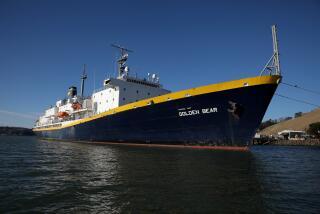To Hawaii, Tahiti, Antarctica and Back--This Time Intact
- Share via
This time, the boat and its crew made it back to the mainland in one piece.
A year ago, high seas disabled the Bonaire, a 66-foot fiberglass ketch, forcing a crew of Orange Coast College students and professional sailors to abandon the boat in the middle of the Pacific Ocean.
But this year, the seas were much calmer and the 65-foot Alaska Eagle was much sturdier. The Alaska Eagle’s nine-member crew of students and professionals arrived safely in Newport Harbor on Tuesday afternoon after a 16-day journey from Honolulu.
The Hawaii to Newport Beach trip was the final leg of the Alaska Eagle’s 27,000-mile, 12 1/2-month journey that included stops in some of the world’s most remote and exotic spots--Antarctica, Easter Island, Pitcairn Island and Tahiti. More than 200 students took part on the various legs.
There was a busted transmission that had to be replaced in Argentina and a few other minor mishaps along the way. But nothing even came close to the collapsed mast step that the Bonaire’s crew encountered on the way back from a yacht race to Hawaii. After a few anxious days in the middle of the Pacific, the crew hitched rides on passing commercial ships bound for Panama.
The Alaska Eagle crew’s most harrowing experience along that same route was a ripped sail about halfway through the 2,000-mile trip.
“We spent the day down below sewing,” said Sheree Austin-Gagne, 46, a sailing novice from Shepperton, England. “It was quite interesting. It felt like we were in a club or something.”
The rest of the journey aboard the aluminum training sloop was relatively uneventful. And no one seemed to be complaining.
“Two nights ago, we had a lot of rocking and rollin’ because of some high winds,” said Sheri Crane, who helped skipper the boat for 11 legs. “But mostly, the wind was pretty soft and lazy.”
Robert Dalrymple, 26, who works in the college’s sailing program with a few crew members from the Bonaire, said last summer’s ill-fated trip wasn’t a hot topic aboard the Alaska Eagle.
“We had the spot marked where they abandoned ship, and we passed right over it,” Dalrymple said. “But out of respect to the sailing gods, it’s not something you go on about.”
Crane, who has been sailing the Alaska Eagle with her husband since it was donated to the college 20 years ago, said the Bonaire disaster never worried her.
“Of course, you don’t ever want to become complacent,” she said. “But we know this boat well, and we have a lot of confidence in it.”
For good reason. In 20 years, the Alaska Eagle has logged more than 250,000 miles.
“This is by far the flagship boat of the school,” said Brad Avery, the sailing school’s director. “It’s very well-suited to what we do. It’s outlasted some rugged seas and taught our students plenty of seamanship skills. It’s built to race around the world, and it’s been coming back for 20 years.”
When the Alaska Eagle arrived, it was escorted into the harbor by five other boats from the school’s fleet.
Crane, who has been at sea for nearly a year, said it felt good to be back on dry land.
“I’m looking forward to sleeping in my own bed,” she said. “And finally having some space to move around in.”
The Alaska Eagle will be busy for the rest of the summer, taking sailing students to Santa Catalina Island, the Channel Islands and San Francisco. In November, it will undergo six months of maintenance work before heading to Hawaii in June 2003 as a support boat for a transpacific yacht race. From there, it’s on to Australia.
More to Read
Sign up for The Wild
We’ll help you find the best places to hike, bike and run, as well as the perfect silent spots for meditation and yoga.
You may occasionally receive promotional content from the Los Angeles Times.






